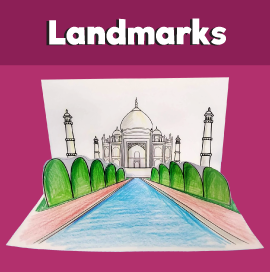India – Free Lesson Plan and Worksheets
Lesson
Grade Level: K-2 Activity Time: 15-20 Minutes
Materials
- Pictures of Mehndi (Henna art) from India
- Pictures of Hindu and Muslim Henna art for comparison
- Mehndi Hand Worksheet
- Pencil
- Markers (both bold and fine tip)
Introduction
Mehndi is the art of henna painting on the body. It’s a popular form of expression in parts of India, Africa, and the Middle East. Dried henna plants are crushed and turned into a paste that creates a temporary dye. The dye is used to make designs to decorate the skin (usually on the hands and feet) and it lasts up to 3 weeks. It’s sort of like a temporary tattoo. Mehndi is usually used for wedding ceremonies and other cultural celebrations. In Muslim tradition, the groom’s family sends Henna to the bride before the wedding ceremony. An artist will apply the Henna tattoo designs on the bride’s hands. In Muslim culture, intricate swirls and lattices with floral patterns decorate the bride’s hands and feet. In Hindu traditions, the bride has a greater variety of design. The purpose of Henna in weddings isn’t just for decoration. Both Hindu and Muslim tradition believe Henna wards off the evil. It’s also believed the deeper the color of the Henna on the bride’s hands, the stronger the love between the new husband and wife.
Henna, the plant used to create dye for mehndi art, is used for many other things. It was used in the past to create cave art. One of the oldest cave paintings made of henna (dating back to 400 BC) can be seen in Ajanta, India. Henna was also used in the past to color skins leather, silk, and wool. Today, henna can be used to treat blisters and rashes, dye hair and material, and of course, create mehndi art.
Guiding Questions
- What are some ways you dress up to celebrate special occasions/traditions?
- Has there ever been a time where you had a design painted on your body? (You might encourage children to think of something like face painting) What was the picture/design? How was it the same/different from the pictures you see of Mehndi?
Activity
- Have students look at the pictures of Mehndi from India. This practice differs from country to country, so it might be helpful to post a few different pictures and give children the opportunity to draw comparisons. Create notes on the board of students’ observations. Here are some ideas for starting the conversation:
- What shapes/designs do you see?
- Are all the lines the same width? What do you notice about the lines?
- Give each student a Mehndi Hand Worksheet
- Encourage students to lightly draw their design with pencil first. Have them trace the lines with marker, and guide them toward using different sized markers to change the size of the lines
- Have students share their design with their peers. Once children have had the opportunity to share, hang their designs around the classroom.
- What designs did you use to create your henna art?
- Which tradition inspired your art?




